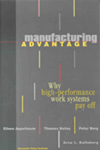 February 2000 EPI Book
February 2000 EPI Book
Manufacturing Advantage
Why High-Performance Work Systems Pay Off
Eileen Appelbaum, Thomas Bailey, Peter Berg,
and Arne L. Kalleberg.
TABLE OF CONTENTS
CHAPTER 1: Manufacturing in the Twenty-First Century
CHAPTER 2: Discretionary Effort and the Organization of Work
CHAPTER 3: Market Dynamics and Work Organization in the Steel Industry
CHAPTER 4: Market Dynamics and Work Organization in the Steel Industry
CHAPTER 5: Market Dynamics and Work Organization in the Medical Electronic Instruments and Imaging Industry
CHAPTER 6: Workplace Transformation and Its Effects on plants and Workers
CHAPTER 7: Measuring the Components of High-Performance Work Systems
CHAPTER 8: Performance Effects of High-Performance Work Systems
CHAPTER 9: High-Performance Work Systems and Worker Outcomes
CHAPTER 10: Effects of High-Performance Practices on Earnings
CHAPTER 11: Work Systems and Productivity Growth
BIBLIOGRAPHY
SUMMARY
Much of the hoopla surrounding quality circles, teams, and high-performance work systems has been based on anecdotes and very thin evidence. It has not been established that those employee involvement strategies amount to anything more than another series of management fads or ruses designed to get more out of workers without giving them anything in return. This revelatory book, written by some of the skeptics, lays some of the suspicion to rest.
Based on their visits to 44 plants and surveys of more than 4,000 employees, Eileen Appelbaum, Thomas Bailey, Peter Berg, and Arne L. Kalleberg concluded that companies are indeed more successful when managers share knowledge and power with workers and when workers assume increased responsibility and discretion.
The study of steel, apparel, and medical electronics and imaging plants revealed much. In self-directed teams, workers were able to eliminate bottlenecks and coordinate the work process. In task forces created to improve quality, they communicated with individuals outside their own work groups and were able to solve problems. Expensive equipment in steel mills operated with fewer interruptions, turnaround and labor costs were cut in apparel factories, and costly inventories of components and medical equipment were reduced.
And what did the employees think? The worker survey showed that jobs in participatory work systems often provide more challenging tasks and more opportunities for creativity. Employees in apparel had higher hourly earnings; those in steel had both higher hourly earnings and higher job satisfaction. Workers in more participatory settings were no more likely than others to report heavy workloads or excessive demands on their time. They were, however, less likely to report involuntary overtime or conflict with co-workers, and were more likely to be satisfied with their surroundings.
Manufacturing Advantage provides the best assessment available of the effectiveness of high-performance work systems. Freestanding chapters near the end of the book provide full documentation of research data without interrupting the narrative flow.
Eileen Appelbaum is Research Director at the Economic Policy Institute in Washington, D.C. Formerly Professor of Economics at Temple University, she is author or coauthor of several books including The New American Workplace: Transforming Work Systems in the United States, also from Cornell. An expert on the apparel industry, Thomas Bailey is Professor of Economics of Education and Director of the Institute on Education and the Economy at Columbia University. He is author or coauthor of three books, most recently Learning to Work. Peter Berg, formerly a labor economist at the Economic Policy Institute, is Assistant Professor in the School of Labor and Industrial Relations at Michigan State University. Arne L. Kalleberg is Kenan Professor of Sociology and Chair of the department at the University of North Carolina, Chapel Hill. He has coauthored or edited four books, the most recent of which (coauthored with David Knoke, Peter Marsden, and Joe Spaeth) is Organizations in America: A Portrait of Their Structures and Human Resource Practices.
“[Manufacturing Advantage] seeks to focus on what may sound an unfashionable topic nowadays — the future of US manufacturing in a competitive global economy…What this impressive book demonstrates is that manufacturing and information technology, far from being separate sectors, are in fact firmly interrelated.” — Robert Taylor, Financial Times
“Manufacturing Advantage is essential reading for anyone interested in work organization in the United States. It is unique in its combination of establishment and employee data and its power is enhanced by its research across three quite different industries. Its findings are important and persuasive–a terrific book.” — Paul Osterman, MIT, Sloan School
“This is an excellent piece of research that will be of interest to a large audience in both academic and public policy circles.” — Harry Katz, Cornell University
“Manufacturing Advantage is a very thorough, technically sound, original contribution to our understanding of the role that high performance work systems are playing in manufacturing.” — Thomas Kochan, MIT, and President, Industrial Relations Research Association
“Fresh and surprising evidence for the idea that employee empowerment and shop-floor participation are not only good for workers but a major source of competitive advantage. Skeptics in management and labor will have to come to terms with this book.” — Charles Derber, author of Corporation Nation: How Corporations Are Taking Over Our Lives and What We Can Do About It
“Manufacturing Advantage is a splendid book–well written, well referenced, filled with data and insight. If high-performance work practices make a difference, can we really just rely on evolutionary processes for their diffusion?” — Jeffrey Pfeffer, Professor, Stanford Business School and author of The Human Equation: Building Profits by Putting People First
Purchase “Manufacturing Advantage“ online.
